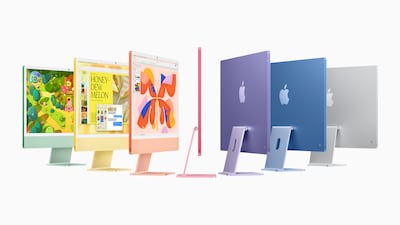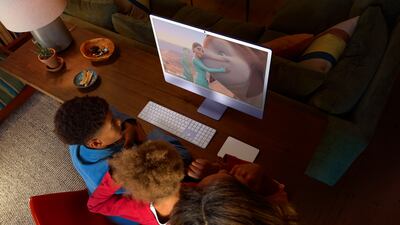As part of Apple's Mac launch week at the end of October, the most colourful – probably figuratively, definitely literally – announcement was the new line of iMacs, which now come with the latest M4 chip.
The company has continuously leaned heavily on boosting its in-house M silicon chips, which were heavily touted in the lead-up and upon its release in 2020. That has allowed the California-based iPhone-maker to tailor its innovations to its minimalist style.
That rings most true for the iMac, which we can consider as the Air version of Apple's desktops. The National takes a look at the new M4 iMac, which, as a nod to the colour we received, is one mean green machine.
Design: Compact as ever
The iMac has always been eye candy, most famously with the "jelly bean" iteration of 1998's iMac G3. But we're happy with how it has evolved to become the minimalistic machine we're all familiar with.
As with the M1 and M3 iMacs – Apple skipped the M2 for this machine – the M4 iMac retains a 61cm display within a 54.7-by-46.1cm frame, the thickness of which clocks in, impressively, at just under 1.2cm. The way Apple's M silicon chips were built, which integrates several components into one board, allows the iMac to cram everything into that tiny frame.
The power switch is behind the screen on the lower-left corner, while USB-C/Thunderbolt 4 ports (Thunderbolt is the high-speed USB connection developed by Apple and Intel, initially for the MacBook Pro) are on the opposite side; you get two of them with the base 8-core M4 (the model we're reviewing), while the 10-core models have four. There is also a 3.5mm audio jack port on the lower-left side.
The input hardware will also depend on the chip you're getting: the 8-core M4 comes with a Magic Keyboard, upgradeable to one with a numeric keypad and Touch ID, and Magic Mouse. The 10-core chip gives you the aforementioned upgraded keyboard and mouse. You also have the option to buy a Magic Trackpad.
These peripherals also now come with USB-C, completing Apple's transition to this connectivity standard. Just one thing: the Magic Mouse still has the USB-C port under it, meaning you can't use it while it's charging. We are genuinely wondering why Apple hasn't addressed this design head-scratcher after all these years; maybe better have a trackpad in reserve?
And we would be remiss not to mention the colour co-ordination. The keyboard and mouse match your iMac's shade; in our case, we got green, so we have that minty vibe. That adds to the iMac doubling as good furniture.
Here's a caveat though: before, you had the option to buy both the mouse and keypad, colours matched, when buying an iMac, but now you can only get one or the other. And if you do decide to buy the one you didn't get, you'll be limited to white and black options. It is unclear why Apple have decided on this.
Meanwhile, the woven and sturdy power cable, which won't give you worries about bending it, is also colour-matched. In addition, you can swap out the standard power adaptor for one with a built-in gigabit ethernet port, which automatically comes with the models with four USB-C ports.
Speaking of colours, you still get the same options: blue, green (which we have), orange, pink, purple, yellow and silver (which you may mistake for white), though Apple says these are "fresh shades". While both the previous and latest iMac colour wheels are great, we'd like to lean towards the new looks, as they're easier on the eyes.

M4 complements Apple Intelligence
Apple normally does not provide figures that compare its latest M chip to its direct predecessor. It says the M4 iMac is up to 2.1 times faster than the M1 and up to six times that of an Intel-based iMac. And when the M4 was first launched, they claimed that, compared to the M2, its CPU was up to 50 per cent faster and its GPU up to four times better. Reported benchmarking tests have shown that the bump-up between the M4 and the M3 is smaller, which is quite expected.
In any case, the M4 iMac delivers on speed and performance. The M4 chip works in tandem with Apple Intelligence, which we've already touched on: with Apple's take on generative AI, you can (for now) perform tasks such as summarising and prioritising messages, cleaning up and editing images (make unwanted elements disappear, for example,) and enjoy a sometimes-too-fast Siri.
Do note that you have to upgrade to macOS Sequoia 15.1 to access Apple Intelligence. In addition, only M-chip based iMacs can utilise it, so if you have an Intel-based one, maybe now's the time to upgrade.
As for the hardware, Apple decided to double the base RAM to 16GB, which is a great move especially considering that the crew over at Cupertino maintained the iMac's prices. You can configure a two-port M4 iMac to 24GB, while the four-port versions go up at 32GB, a new high for the device. This unified memory greatly works in tandem with the 16-core Neural Engine.
Storage, meanwhile, remains at 256GB, 512GB and 1TB for the base M4 iMac, with an additional 2TB option for the four-port models. Now we know storage devices – in particular, solid-state drives, which the iMacs use – are expensive, but we'd be highly appreciative if we got a 512GB base. Backing up a 256GB iPhone on an iMac with the same storage won't be possible, so you get our point here.
Verdict
With a base price of Dh5,499 in the UAE, the entry-level M4 iMac is a sturdy machine – but you'll have to shell out more cash for it, being more expensive compared to most other all-in-ones in the market. We are surprised at the removal of the mouse-and-trackpad combo from the get-go, and at the mouse's charging port still being on its underside.
It can be argued, however, that this is another token upgrade from Apple, and considering the gap between the M1 iMac in 2021 and last year's M3 version, it can be argued that the shift to M4, in just over a year, was made to keep its entire portfolio in line with each other.
Having said that, we expect something very exciting in the M5. The iMac, save for its evolving chip, has essentially remained the same for the past three years, so something outstanding, maybe long overdue, should be coming up. But make no mistake: this machine is definitely more than just eye candy.


